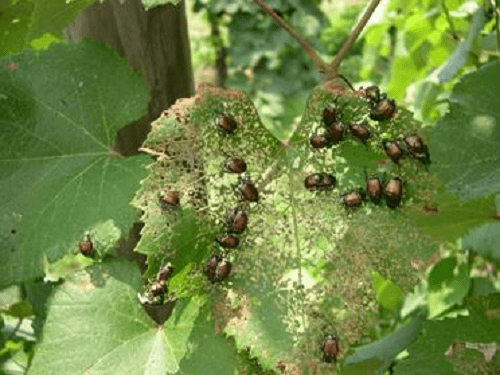Keeping Japanese beetles at bay has been a losing battle for many Kentuckians since its introduction in the state during the 50’s and 60’s. Controlling these pests prove challenging for even the most seasoned gardeners. So what’s a homeowner to do? Options include plant selection, handpicking or exclusion, or insecticides.
Plant Selection:
Carefully selecting plant species when replacing or adding to your landscape could be the key to avoiding an annual battle with Japanese beetles. Although Japanese beetles feed on about 300 species of plants, they feed sparingly or not at all on many common trees and shrubs.
These include: red maple; silver maple; boxwood; flowering dogwood; euonymus (all species); white ash, green ash; holly (all species); tuliptree; magnolia (all species); red mulberry; white poplar; common pear; white oak; scarlet oak; red oak; black oak; rhodendron; American elder; and common lilac. Likewise, most evergreen ornamentals, including Abies (fir), Juniperus, Taxus, Thuja (arborvitae), Rhodendron, Picea (spruce), Pinus (pine) and Tsuga (hemlock) are not attacked. Boxelder, shagbark hickory, persimmon and American sweetgum are also options but may suffer occasional light feeding.
Plants to avoid using in your landscape include: Japanese maple; Norway maple; horse chestnut; hollyhock; gray birch; American chestnut; Rose-of-Sharon; shrub althea; black walnut; flowering crabapple; apple; London planetree; Lombardy poplar; cherry, black cherry, plum and peach trees; rose; sassafras; American mountain-ash; American linden; American elm; English elm; and table grapes. These plants are nearly always severely attacked by Japanese beetles.
Hand Picking and Exclusion:
For smaller plants, it may be practical simply to remove the beetles by hand. Volatile odors released from beetle-damaged leaves attract more beetles. By not allowing Japanese beetles to accumulate, plants will be less attractive to other beetles. One of the easiest ways to remove beetles from small plants is to shake them off early in the morning when the insects are sluggish. The beetles can be killed by shaking them into a bucket of soapy water. Highly valued plants such as roses can be protected by covering them with cheesecloth or other fine netting during peak beetle activity (usually late June to mid-July).

Creating a habitat that is less suitable for Japanese beetles might be helpful. Japanese beetles are fond of certain weeds and non-economic plants such as multiflora rose, Indian mallow, poison ivy, smartweed, and wild summer grape. If you get rid of these plants, you will likely eliminate a continuous source of infestation.
Insecticides:
Foliar sprays of carbaryl and several pyrethorid products such as bifenthrin, cyfluthrin and permethrin are labeled for control of adult Japanese beetles. Pyrethroids generally give 2-3 weeks protection of plant foliage while carbaryl gives 1-2 weeks protection. Foliage and flowers should be thoroughly treated. The application may need to be repeated to prevent re-infestation during the adult flight period. Follow label directions and avoid spraying under windy conditions. Imidacloprid can also be applied as a soil drench in late winter or spring to susceptible plants to greatly reduce foliar feeding by this pest next summer.
Botanical alternatives including Neem or Pyola provide about 3-4 days deterrence of Japanese beetle feeding. Insecticidal soap, extracts of garlic, hot pepper, or orange peels, and companion planting, however, were found to be non-effective.
— Kelly Jackson, Christian County Extension Agent for Horticulture





